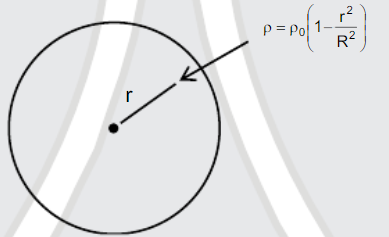The mass density of a planet of radius R varie with the distance r form its centre as ρ(r)=p0(1−r2R2). Then the graviational field is maximum at :
r=√59R
r=1√3R
r=R
r=√34R
To find the radius at which the gravitational field is maximum for a planet with a given density variation, we can follow these steps:
Step 1: Understand the Density Function
The mass density of the planet varies with the distance r from its center as:
ρ(r)=ρ0(1−r2R2)
where ρ0 is the density at the center and R is the radius of the planet.
Step 2: Calculate the Mass Enclosed within Radius r
To find the gravitational field, we first need to calculate the mass enclosed within a radius r:
M(r)=∫r0ρ(r′)⋅dV
The volume element in spherical coordinates is dV=4πr′2dr′. Thus,
M(r)=∫r0ρ0(1−(r′)2R2)4π(r′)2dr′
Step 3: Evaluate the Integral
Now, we evaluate the integral:
M(r)=4πρ0∫r0((r′)2−(r′)4R2)dr′
Calculating the two parts of the integral:
1. ∫r0(r′)2dr′=r33
2. ∫r0(r′)4dr′=r55
Thus,
M(r)=4πρ0(r33−r55R2)
Step 4: Calculate the Gravitational Field
The gravitational field g(r) at a distance r from the center is given by:
g(r)=GM(r)r2
Substituting M(r):
g(r)=G⋅4πρ0(r33−r55R2)r2
Simplifying this gives:
g(r)=4πGρ03r−4πGρ05R2r3
Step 5: Find the Maximum Gravitational Field
To find the radius r at which g(r) is maximum, we differentiate g(r) with respect to r and set it to zero:
dgdr=4πGρ03−12πGρ05R2r2=0
Solving for r:
4πGρ03=12πGρ05R2r2
r2=4R25
r=2R√5
Conclusion
The gravitational field is maximum at:
r=2R√5
The mass density of the planet varies with the distance r from its center as:
ρ(r)=ρ0(1−r2R2)
where ρ0 is the density at the center and R is the radius of the planet.
To find the gravitational field, we first need to calculate the mass enclosed within a radius r:
M(r)=∫r0ρ(r′)⋅dV
The volume element in spherical coordinates is dV=4πr′2dr′. Thus,
M(r)=∫r0ρ0(1−(r′)2R2)4π(r′)2dr′
Now, we evaluate the integral:
M(r)=4πρ0∫r0((r′)2−(r′)4R2)dr′
Calculating the two parts of the integral:
1. ∫r0(r′)2dr′=r33
2. ∫r0(r′)4dr′=r55
M(r)=4πρ0(r33−r55R2)
The gravitational field g(r) at a distance r from the center is given by:
g(r)=GM(r)r2
Substituting M(r):
g(r)=G⋅4πρ0(r33−r55R2)r2
Simplifying this gives:
g(r)=4πGρ03r−4πGρ05R2r3
To find the radius r at which g(r) is maximum, we differentiate g(r) with respect to r and set it to zero:
dgdr=4πGρ03−12πGρ05R2r2=0
Solving for r:
4πGρ03=12πGρ05R2r2
r2=4R25
r=2R√5
The gravitational field is maximum at:
r=2R√5
Topper's Solved these Questions
Similar Questions
The earth is a homogeneous sphere of mass M and radius R. There is another spherical planet of mass M and radius R whose density changes with distance r from the centre as p=p0r. (a) Find the ratio of acceleration due to gravity on the surface of the earth and that on the surface of the planet. (b) Find p0.
View SolutionThe mass density of a spherical galaxy varies as Kr over a large distance 'r' from its centre . In that region , a small star is in a circular orbit of radius R . Then the period of revolution , T depends on R as :
View Solution
Knowledge Check
A cylindrical wire of radius R has current density varying with distance r form its axis as J(x)=J0(1−r2R2) . The total current through the wire is
AπJ0R22B2πJ0R23C4πJ0R23Dnone of theseMass density of sphere having radius R varies as ρ=ρ0(1−r2R2) . Find maxium magnitude of gravitational field
 A4π3(Gρ0R)B2π√35(Gρ0R)C8π√527(Gρ0R)D2π√527(Gρ0R)
A4π3(Gρ0R)B2π√35(Gρ0R)C8π√527(Gρ0R)D2π√527(Gρ0R)The distance of the centre of mass of a hemispherical shell of radius R from its centre is
AR2BR3C2R2D2R3
A spherical region of space has a distribution of charge such that the volume charge density varies with the radial distance from the centre r as ρ=ρ0r3,0≤r≤R where ρ0 is a positive constant. The total charge Q on sphere is
View SolutionCharge density of a sphere of radius R is ρ=ρ0r where r is distance from centre of sphere.Total charge of sphere will be

View SolutionIf mass density of earth varies with distance 'r' from centre of earth as ρ=krand'R'isradius of earth, then find the orbital velocity of an object revolving around earth at adistance '2R' from its centre.
View SolutionConsider a spherical planet of radius R . Its density varies with the distance of its centre t as ρ=A−Br, where A and B are positive constants. Now answer the following questions.
For B=0 , pressure due to gravitation force at a distance r(<R) from the centre of the planet is
View SolutionConsider a spherical planet of radius R . Its density varies with the distance of its centre t as ρ=A−Br, where A and B are positive constants. Now answer the following questions.
Acceleration due to gravity at a distance r(r<R) from its centre is
View Solution
